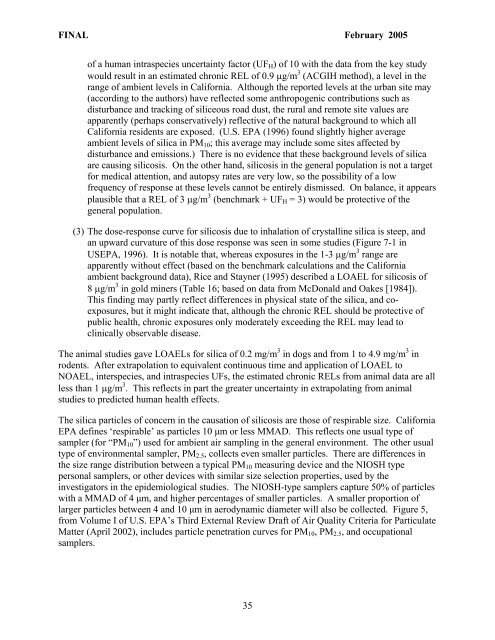Silica (crystalline, respirable) - OEHHA
Silica (crystalline, respirable) - OEHHA
Silica (crystalline, respirable) - OEHHA
You also want an ePaper? Increase the reach of your titles
YUMPU automatically turns print PDFs into web optimized ePapers that Google loves.
FINAL February 2005<br />
of a human intraspecies uncertainty factor (UFH) of 10 with the data from the key study<br />
would result in an estimated chronic REL of 0.9 µg/m 3 (ACGIH method), a level in the<br />
range of ambient levels in California. Although the reported levels at the urban site may<br />
(according to the authors) have reflected some anthropogenic contributions such as<br />
disturbance and tracking of siliceous road dust, the rural and remote site values are<br />
apparently (perhaps conservatively) reflective of the natural background to which all<br />
California residents are exposed. (U.S. EPA (1996) found slightly higher average<br />
ambient levels of silica in PM10; this average may include some sites affected by<br />
disturbance and emissions.) There is no evidence that these background levels of silica<br />
are causing silicosis. On the other hand, silicosis in the general population is not a target<br />
for medical attention, and autopsy rates are very low, so the possibility of a low<br />
frequency of response at these levels cannot be entirely dismissed. On balance, it appears<br />
plausible that a REL of 3 µg/m 3 (benchmark + UFH = 3) would be protective of the<br />
general population.<br />
(3) The dose-response curve for silicosis due to inhalation of <strong>crystalline</strong> silica is steep, and<br />
an upward curvature of this dose response was seen in some studies (Figure 7-1 in<br />
USEPA, 1996). It is notable that, whereas exposures in the 1-3 µg/m 3 range are<br />
apparently without effect (based on the benchmark calculations and the California<br />
ambient background data), Rice and Stayner (1995) described a LOAEL for silicosis of<br />
8 µg/m 3 in gold miners (Table 16; based on data from McDonald and Oakes [1984]).<br />
This finding may partly reflect differences in physical state of the silica, and coexposures,<br />
but it might indicate that, although the chronic REL should be protective of<br />
public health, chronic exposures only moderately exceeding the REL may lead to<br />
clinically observable disease.<br />
The animal studies gave LOAELs for silica of 0.2 mg/m 3 in dogs and from 1 to 4.9 mg/m 3 in<br />
rodents. After extrapolation to equivalent continuous time and application of LOAEL to<br />
NOAEL, interspecies, and intraspecies UFs, the estimated chronic RELs from animal data are all<br />
less than 1 µg/m 3 . This reflects in part the greater uncertainty in extrapolating from animal<br />
studies to predicted human health effects.<br />
The silica particles of concern in the causation of silicosis are those of <strong>respirable</strong> size. California<br />
EPA defines ‘<strong>respirable</strong>’ as particles 10 µm or less MMAD. This reflects one usual type of<br />
sampler (for “PM10”) used for ambient air sampling in the general environment. The other usual<br />
type of environmental sampler, PM2.5, collects even smaller particles. There are differences in<br />
the size range distribution between a typical PM10 measuring device and the NIOSH type<br />
personal samplers, or other devices with similar size selection properties, used by the<br />
investigators in the epidemiological studies. The NIOSH-type samplers capture 50% of particles<br />
with a MMAD of 4 µm, and higher percentages of smaller particles. A smaller proportion of<br />
larger particles between 4 and 10 µm in aerodynamic diameter will also be collected. Figure 5,<br />
from Volume I of U.S. EPA’s Third External Review Draft of Air Quality Criteria for Particulate<br />
Matter (April 2002), includes particle penetration curves for PM10, PM2.5, and occupational<br />
samplers.<br />
35















